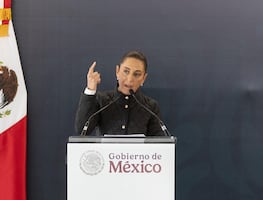Más Información

“Vamos a dar apoyo a los pequeños agricultores por sequía en Sonora”; Claudia Sheinbaum instruye a Berdegué

Derrota de México en disputa por maíz transgénico contra EU; estos son los argumentos de Sheinbaum y AMLO para prohibirlo

Óscar Rentería Schazarino, ha operado contra CJNG, Viagras y Templarios; es el nuevo secretario de Seguridad en Sinaloa

Claudia Sheinbaum pide respeto para Maru Campos; gobernadora anuncia acuerdo para transporte público

Claudia Sheinbaum anuncia los Centros de Cuidado Infantil en Chihuahua; inaugura hospital en Ciudad Juárez
After being closed for up to six months due to the health emergency caused by COVID-19, archeological sites throughout Mexico have begun to gradually reopen in the new normal .
As announced by Mexico’s Culture Minister Alejandra Frausto Guerrero on August 24, “the reopening of spaces, museums, and archeological sites in charge of the National Institute of Anthropology and History (INAH) will be scheduled starting on September 7 in a gradual way.”
Although Mexico’s archeological sites were closed during the coronavirus lockdown, some of them remained virtually opened as they offered online tours in order to promote culture while keeping visitors and staff safe during the most critical stages of the pandemic in the country. As Frausto Guerrero asserted, “culture did not stop and became an essential factor to give people hope.”
The reopening of archeological sites throughout different Mexican states has the objective of reactivating the economy through tourism prioritizing the health of visitors and INAH personnel.
Therefore, tourists will have to wear face masks during their whole visit to the sites and are urged to remain at least 1.5 meters away from others, except for children, who must be accompanied by an adult.
Moreover, the Culture Ministry said visitors must bear in mind that the pandemic is still active, so it is highly important to follow the new health protocols and INAH’s regulations when they visit any archeological site so as to remain safe while also protecting others from the new virus.
Visitors must also check the new time schedules for each site and consider they are only allowed to open at 30% capacity.
In addition, only some areas of the sites are open to the public since some of them might not allow physical distancing and others will undergo maintenance during this period.
Recommended:
Open archeological sites
On August 29, Guanajuato became the first Mexican state to reopen archeological sites.
Plazuelas, Peralta, Cañada de la Virgen, El Cóporo, and Arroyo Seco have been welcoming visitors back since that date under a strict health protocol that aims to prevent the spread of COVID-19.
Campeche became the second state to reopen archeological sites on August 31.
Hormiguero, Xpujil, Dzibilnocac, Balamkú, and Hochob joined the INAH’s and the Culture Ministry’s health measures in order to reopen to tourists.

On September 7, Mexico City reopened the Mixcoac archeological site and Morelos did so with the Chalcatzingo archeological site, one of the most important Olmec cities.
September 8 marked the reopening of the Cuicuilco archeological site in southern Mexico City, although some of its areas will remain temporarily closed.
One of Mexico’s top destinations, Teotihuacan, located in the State of Mexico, joined the list of open archeological sites on September 10.
Rogelio Rivera Chong, director of the Teotihuacan Archeological Site, informed that nearly 600 national and international visitors had come to the site on the first hours of its reopening. Prior to the pandemic, the site received over 6,000 visitors on weekends. However, with the new health regulations , the site will only be able to admit a maximum of 3,000 visitors.

INAH’s health measures were implemented in Quintana Roo for the first time on September 14 as four sites located north of the state reopened.
Northern Quintana Roo was classified as a low COVID-19 risk area and so, Tulum, Cobá, San Gervasio, and Muyil were allowed to receive visitors after months of suspended activities.
Recommended:
That same day, Yucatán began gradually reopening its sites starting with Uxmal, Xcambó, Mayapán, Izamal, and Ek Balam. However, the night show at Uxmal has been canceled.
Chihuahua’s Paquimé archeological site welcomed back visitors starting on September 15; Sonora’s Cerro de Trincheras reopened its doors on September 17.
The majestic Chichén Itzá, Mexico’s new wonder of the world, reopened on September 22 along with Dzibilchaltún.

Chiapas’s Palenque archeological site reopened its doors to tourists on September 26, although it was originally scheduled to do so three days before.
The INAH will continue gradually reopening archeological sites throughout the country in upcoming days under strict COVID-19 health protocols.
mp






